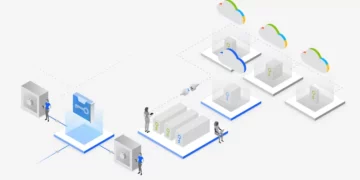
If you’re ready to expand—or even start—your automation and AIOps strategy, you’ve come to the right place. This blog post is ripe with practical next steps that you can use to better understand, help persuade and begin to implement AIOps within your organization. The case for infusing artificial intelligence (AI) into your IT operations is compelling, with tangible benefits and strategic use cases.
First, let’s start with a basic premise—as IT systems become more complex and intertwined, automation is the most essential tool you have at your disposal. We define automation as the application of technology, programs, robotics or processes that help you realize outcomes with minimal human input and at a scale that exceeds human abilities.
Now let’s look at how automation—when applied to IT—helps you achieve better business results in three key areas, along with what every beginner should know to get started.
1. Better application and system performance through observability
AI-powered observability solutions deliver advanced monitoring to provide you with the context you need to resolve incidents faster. Traditional monitoring tools might give you metrics and data, but they often lack the ability to provide a complete picture of the system’s behavior. Observability, on the other hand, focuses on collecting real-time data, logs and traces to create a holistic view of your IT environment.
What beginners should know about observability:
- Observability is not an evolution of application performance monitoring (APM). APM delivers debugging of applications whereas observability delivers an understanding of applications. Watch the video: APM vs. Observability.
- Observability relies on advanced AI algorithms to analyze vast amounts of data quickly and identify patterns and anomalies.
- Observability tools discover conditions you might never know or think to look for, then track their relationship to specific performance issues for root cause analysis and speedier resolution. Read the Enterprise Guide.
- Using observability early in development is a good thing because it allows DevOps teams to identify and fix issues in new code before they impact the end user.
- You can scale automatically with observability. For example, you can specify instrumentation and data aggregation as part of a Kubernetes cluster configuration and start gathering telemetry from the moment it spins up until it spins down.
- Observability benefits systems of all sizes by proactively monitoring critical components and providing early detection of anomalies. Read about observability myths.
2. Optimization and cost control through automated operations
While modern applications and IT systems are growing more complex, many cloud users still fall back on a familiar habit of overprovisioning resources to mitigate any risk to performance. Yet almost a third of organizations estimate that they wasted their cloud spend. Automated operations powered by AIOps can help you break that expensive approach and optimize your IT infrastructure, resource allocation, and cloud usage. By analyzing historical data and real-time metrics, AIOps can help you make intelligent decisions on resource provisioning, ensuring that you scale up or down depending on demand needs. The result is that you can assure application performance at the lowest possible cost.
What beginners should know about automated operations:
- AIOps can help reduce unnecessary infrastructure costs by identifying underutilized resources and recommending their optimization or shutdown. Start by rethinking your cloud operations.
- By automating resource provisioning, you can avoid manual errors and optimize the overall performance of your IT systems.
- A cloud cost optimization platform allows you to continuously automate critical actions in real-time at a scale that can’t be matched by humans, no matter how skilled.
- FinOps (Finance + Operations) is an evolving financial management framework that can be included in automations operations to help deliver cost savings and faster innovation. Watch the video: FinOps for trustworthy cloud automation.
- AI-powered solutions that help you automatically manage operations can also help you create more sustainable IT by reducing waste. Read the guide: Accelerating FinOps and Sustainable IT.
3. Faster incident management and resolution
Incident management is a vital part of IT operations. The speed at which issues can be identified and fixed—the mean time to resolution or MTTR – is often the difference between IT fire drills or happy customers. AIOps uses AI algorithms and data analytics to automate the detection, analysis and resolution of incidents.
Implementing an AIOps platform is an excellent first step for any organization. For example, AIOps platforms can monitor server logs and network data in real-time, automatically identify patterns indicative of an incident and trigger an alert to the IT team. This proactive approach helps IT teams respond swiftly, minimizing disruptions and improving customer satisfaction.
What beginners should know about incident management and AIOps platforms:
- Traditional incident management, which relies on manual time and effort, is quickly being replaced by AI-powered AIOps platform. Read the AIThority article on incident management.
- This AI-powered approach turns incident management from reactive to proactive (and even preventative). Get the Gartner Market Guide.
- AIOps platforms can ingest and correlate data from various sources to provide a comprehensive view of the entire IT landscape.
- Users can share this comprehensive view on a single pane of glass, meaning operational silos and traditional (and time-consuming) war rooms are out and collaboration is in. Read the blog: “Smarter IT operations management with IBM AIOps Insights”
- AIOps platforms may either be self-hosted or implemented as a SaaS solution. That allows organizations of any size to find the solution that works best for them.
- Self-hosted AIOps platforms offer more control and customization options and are a good option for complex operations, while SaaS-based AIOps platforms provide ease of implementation and scalability, allowing organizations to focus on using the platform’s capabilities rather than managing the underlying infrastructure.
Get started with AIOps for your organization
No matter where you are on your digital transformation journey, IBM is here to help. We offer solutions that help you move out of the old “break-fix” model into an AI-powered approach to help you deliver exceptional customer experiences, assure application performance, reduce costs and tackle the many challenges of a modern IT environment.
Learn more about IBM AIOps solutions
More from Artificial intelligence

August 28, 2023
Leveraging user-generated social media content with text-mining examples
7 min read – With nearly 5 billion users worldwide—more than 60% of the global population—social media platforms have become a vast source of data that businesses can leverage for improved customer satisfaction, better marketing strategies and faster overall business growth. Manually processing data at that scale, however, can prove prohibitively costly and time-consuming. One of the best ways to take advantage of social media data is to implement text-mining programs that streamline the process. What is text mining? Text mining—also called text data…
<!—->

August 28, 2023
How Macmillan Publishers authored success using IBM Cognos Analytics
5 min read – Macmillan Publishers is a global publishing company and one of the “Big Five” English language publishers. If you’re a reader, chances are good you’ve read a book from Macmillan. They published many perennial favorites including Kristin Hannah’s The Nightingale, Bill Martin’s Brown Bear, Brown Bear, what do you see? and some of the more recent bestsellers such as The Silent Patient by Alex Michaelides, Identity by Nora Roberts and Razorblade Tears by S. A. Cosby. It’s no wonder then that Macmillan…
<!—->

August 24, 2023
2018 Call for Code Winner Project OWL advances its natural disaster communication network
3 min read – For disaster-prone areas, fragile connectivity remains a major problem, often going offline in critical moments. Aerospace enterprises face a similar challenge when trying to run consistent high-altitude connectivity while operating in remote locations, which can also be very expensive. This is where Project OWL comes into play: developing new technologies to help address these challenges. Formed in 2018 to compete in the inaugural Call for Code Global Challenge — which it won — Project OWL is a global team of entrepreneurs…
<!—->

August 23, 2023
Why data governance is essential for enterprise AI
5 min read – The recent success of artificial intelligence based large language models has pushed the market to think more ambitiously about how AI could transform many enterprise processes. However, consumers and regulators have also become increasingly concerned with the safety of both their data and the AI models themselves. Safe, widespread AI adoption will require us to embrace AI Governance across the data lifecycle in order to provide confidence to consumers, enterprises, and regulators. But what does this look like? For the…
<!—->
- SEO Powered Content & PR Distribution. Get Amplified Today.
- PlatoData.Network Vertical Generative Ai. Empower Yourself. Access Here.
- PlatoAiStream. Web3 Intelligence. Knowledge Amplified. Access Here.
- PlatoESG. Automotive / EVs, Carbon, CleanTech, Energy, Environment, Solar, Waste Management. Access Here.
- PlatoHealth. Biotech and Clinical Trials Intelligence. Access Here.
- ChartPrime. Elevate your Trading Game with ChartPrime. Access Here.
- BlockOffsets. Modernizing Environmental Offset Ownership. Access Here.
- Source: https://www.ibm.com/blog/a-beginners-guide-to-automation-and-aiops/
- :has
- :is
- :not
- :where
- $UP
- 11
- 2018
- 2023
- 23
- 24
- 25
- 28
- 30
- 300
- 31
- 39
- 40
- 9
- a
- abilities
- ability
- About
- Achieve
- across
- actions
- address
- Adoption
- advanced
- advances
- ADvantage
- Advertising
- Aerospace
- aggregation
- AI
- AI adoption
- AI governance
- AI models
- AI-powered
- AIOps
- Alert
- alex
- algorithms
- All
- allocation
- Allowing
- allows
- along
- also
- amounts
- amp
- an
- analysis
- analytics
- analyze
- analyzing
- and
- any
- Application
- applications
- applied
- approach
- ARE
- areas
- article
- artificial
- artificial intelligence
- AS
- At
- AUGUST
- author
- authored
- automate
- Automated
- automatically
- automating
- Automation
- avoid
- back
- based
- basic
- BE
- Bear
- because
- become
- before
- begin
- Beginner
- Beginners
- behavior
- being
- benefits
- BEST
- Better
- between
- Bill
- Billion
- Blog
- blogs
- book
- Books
- both
- Break
- brown
- business
- businesses
- but
- by
- call
- called
- CAN
- capabilities
- carbon
- card
- Cards
- case
- CAT
- Cause
- challenge
- challenges
- chances
- check
- CIS
- class
- Cloud
- Cluster
- code
- collaboration
- Collecting
- color
- come
- comes
- commitment
- Communication
- company
- compelling
- compete
- complete
- complex
- components
- comprehensive
- concerned
- conditions
- confidence
- Configuration
- Connectivity
- consistent
- Consumers
- Container
- content
- context
- continue
- continuously
- control
- Cost
- cost savings
- costly
- Costs
- could
- create
- critical
- CSS
- custom
- customer
- Customer satisfaction
- Customers
- customization
- data
- Data Analytics
- Date
- decisions
- Default
- define
- definitions
- deliver
- delivers
- Demand
- Depending
- description
- Detection
- developing
- Development
- difference
- digital
- Digital Transformation
- disaster
- discover
- disruptions
- do
- does
- down
- Early
- ease
- effort
- either
- embrace
- Employee
- end
- English
- ensuring
- Enter
- Enterprise
- enterprises
- Entire
- Environment
- Errors
- essential
- estimate
- Ether (ETH)
- Even
- Every
- evolution
- evolving
- example
- examples
- exceeds
- excellent
- exceptional
- Exit
- expensive
- Experiences
- Face
- Fall
- familiar
- faster
- Favorites
- female
- finance
- financial
- financial management
- Find
- Fire
- First
- Fix
- Focus
- focuses
- follow
- fonts
- For
- formed
- FRAME
- Framework
- from
- full
- Gartner
- gathering
- generator
- get
- Give
- glass
- Global
- going
- good
- governance
- Grid
- Growing
- Growth
- guide
- hand
- happy
- Have
- height
- help
- helps
- here
- historical
- holistic
- How
- However
- HTTPS
- human
- Humans
- IBM
- ICO
- ICON
- identified
- identify
- identifying
- Identity
- if
- image
- Impact
- implement
- implementation
- implemented
- improved
- improving
- in
- Inaugural
- incident
- included
- Including
- increasingly
- index
- indicative
- Infrastructure
- Innovation
- input
- Intelligence
- Intelligent
- into
- issues
- IT
- ITS
- journey
- jpg
- Key
- Key Areas
- Know
- Lack
- landscape
- language
- laptop
- large
- Leverage
- leveraging
- lifecycle
- like
- locale
- locations
- Look
- look like
- lowest
- major
- make
- man
- manage
- management
- manager
- managing
- manual
- manually
- many
- Market
- Marketing
- Marketing Strategies
- matched
- Matter
- max-width
- May..
- mean
- meaning
- Media
- Metrics
- might
- min
- minimal
- minimizing
- Mining
- minutes
- Mitigate
- Mobile
- model
- models
- Modern
- moment
- Moments
- Monitor
- monitoring
- more
- most
- move
- Natural
- Navigation
- nearly
- Need
- needs
- network
- Network Data
- networking
- never
- New
- New technologies
- next
- night
- no
- nothing
- of
- offer
- Office
- offline
- often
- Old
- on
- ONE
- operating
- operational
- Operations
- optimization
- Optimize
- optimized
- Option
- Options
- or
- order
- organization
- organizations
- Other
- out
- outcomes
- overall
- owl
- page
- pane
- part
- patient
- patterns
- performance
- phone
- PHP
- picture
- Place
- planning
- platform
- Platforms
- plato
- Plato Data Intelligence
- PlatoData
- Play
- plugin
- policy
- position
- possible
- Post
- powered
- Practical
- Proactive
- Problem
- process
- processes
- processing
- professional
- Programs
- project
- proposal
- Prove
- provide
- providing
- published
- publishers
- Publishing
- pushed
- quickly
- rather
- RE
- Read
- Reader
- Reading
- ready
- real-time
- real-time data
- realize
- recent
- recommending
- reduce
- reducing
- Regulators
- relationship
- remains
- remote
- replaced
- require
- research
- Resolution
- resource
- Resources
- Respond
- responsive
- result
- Results
- review
- right
- Risk
- robotics
- robots
- Rooms
- Run
- s
- safe
- Safety
- satisfaction
- Savings
- Scalability
- Scale
- Screen
- scripts
- see
- seo
- Share
- shelves
- should
- shutdown
- silos
- similar
- single
- site
- Size
- sizes
- skilled
- small
- Social
- social media
- solution
- Solutions
- some
- Source
- Sources
- specific
- speed
- spins
- Sponsored
- start
- started
- Step
- Steps
- Still
- strategies
- Strategy
- streamline
- success
- such
- sustainable
- swiftly
- system
- Systems
- Tablet
- tackle
- Take
- team
- teams
- Technologies
- Technology
- than
- that
- The
- their
- Them
- theme
- themselves
- then
- These
- they
- thing
- Think
- Third
- this
- three
- Through
- Tim
- time
- time-consuming
- Title
- to
- tool
- tools
- top
- track
- traditional
- Transform
- Transformation
- trigger
- trustworthy
- turns
- type
- underlying
- understand
- understanding
- unnecessary
- until
- URL
- us
- Usage
- use
- User
- users
- uses
- using
- various
- Vast
- Ve
- very
- Video
- View
- vital
- vs
- W
- war
- Waste
- Watch
- ways
- we
- What
- What is
- when
- whereas
- which
- while
- why
- widespread
- will
- winner
- with
- within
- woman
- Won
- WordPress
- works
- written
- XML
- yet
- you
- Your
- youtube
- zephyrnet












